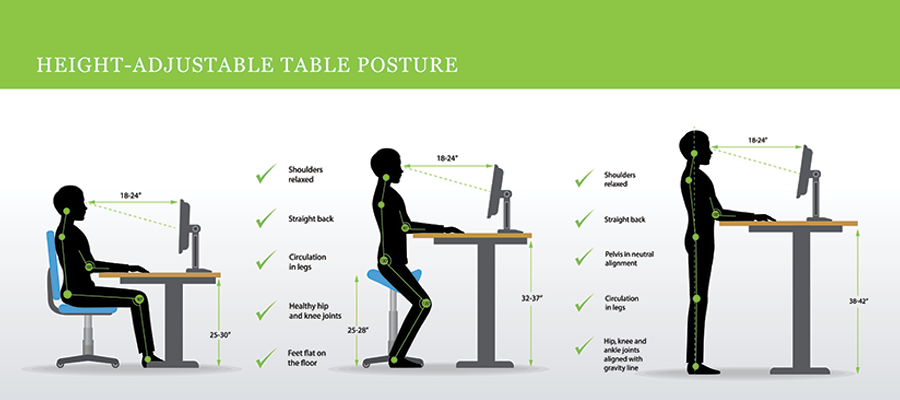
Not too long ago, working from home was a sought-after luxury. A person could save time with a short commute, make one’s own work schedule, and wear slippers. Often, a dedicated workspace was strategically set up for optimal ergonomics and facilitation of productivity.
Since then, many of us have had the opportunity to work from home. As temporary and spontaneous measures, most people worked in the home environment without setting up a dedicated workspace.
Recently, working from home (WFH) has meant long hours, back-to-back meetings, shared workspaces, and less than optimal ergonomics. This has led to aches and pains of the back and neck as well as the arms, wrists, and hands.
Where and how we work has potentially changed forever. It is, therefore, important to learn how to prevent and treat work-related aches and pains. Below, we will share how to set up an ergonomic workstation at home. As well, we will share how to work more ergonomically at home and in the office as well.
The Downside of The Short Commute
The move towards WFH has meant long hours at the computer. Along with headaches and eyestrain, long hours of typing, using the mouse, and different devices leads to repetitive strain of delicate hand and wrist structures.
Side Effects of Working from Home (WFH)
Lack of socialising and face-to-face interactions may result in a loss of social supports. This may contribute to feelings of social isolation and even depression.
Many people who work from home report issues, aches, and pains in the low back and neck.
Prolonged sedentary activities as well as poor body mechanics due to improper workstation set up shows an increase in bodily pain and discomfort.
Arms and hands begin to feel tired and fatigued followed by increased musculoskeletal pain related to overuse of muscles, bones, ligaments, tendons, and nerves of the hands and wrists.

Are You Home Sick?
Working from home is challenging, in many ways. Studies show that 65% of people who WFH report new physical health issues, and 74% have new mental health issues. Balancing the blurred work-life boundaries, sharing workspaces with family members, all while staying productive often places our mental and physical well-being at a low-priority.
We have made make-shift office spaces in closets or corners. Some of us tend to move from couch, to bed, to kitchen table while making room for the needs of our other home-bound family members. Long hours of screentime in awkward positions have played a detrimental role on our musculoskeletal systems.

Overuse and Misuse Leads to Aches and Pains
Gradual overuse caused by long hours of typing, or other repetitive motions may cause symptoms of an overuse syndrome. Combined with doing these actions in slouched or awkward positions may be injurious and cause aches and pains. Symptoms usually present themselves first in the hands, arms, and wrists. These symptoms may include swelling and numbness and may lead to loss of mobility.

Common Hand and Wrist Conditions Related to Working from Home
Overuse syndrome or similar repetitive motion disorders can progress into further ailments of the hand and wrist. Tendons of the wrist can become irritated or inflamed. This is known as tendinitis. De Quervain’s tenosynovitis, specifically, effects the tendons of the thumb and wrist. Trigger finger, or stenosing tenosynovitis is a progression of overuse of the flexor tendons, which become swollen and locked. Ligaments might become inflamed with overuse or misuse which leads to capsulitis. Other common hand and wrist conditions that are related to WFH are strains and injuries of muscles or tendons.
Diagnosis and When to See a Doctor
Importantly, see your doctor about new or ongoing hand and wrist pain promptly. A doctor can provide evaluation, diagnosis, and potential prevention, therapeutic, and treatment options. A doctor may also provide recommendations and referrals to a higher level of care such as a Specialist Hand Surgeon.
A Specialist Hand Surgeon can provide a definitive diagnosis, advise prevention and treatment options, as well as provide ongoing occupational or physical therapy.
A doctor or Specialist Hand Surgeon may diagnose an overuse or repetitive motion disorder by first asking questions about your symptoms, their history, and your medical history followed by a thorough physical exam. Ongoing tests might include x-rays, MRI, and nerve conduction studies.
Potential Causes of Hand and Wrist Aches and Pains
Unlike the flexibility of traditional WFH, the abrupt shift to working from home during the pandemic has caused us to work in less-than-optimal workspaces. Studies show only about one-third of people working from home have an optimized workstation, while over half use a shared work area or a multipurpose workspace. Moreover, we know, and studies also show, the workday is longer when working from home, by more than 45 minutes per day. Meetings have increased, and taking regular breaks is not always possible considering work intensity and back-to-back meetings. The extended and intense hours with reduced breaks combined with improper workstation ergonomics may be directly linked to increased musculoskeletal discomfort, aches, and pains.

The Home Office – Key to Prevention
Currently, we may have an opportunity to combine the traditional benefits of working from home with current technology. This leap in technology has allowed more people to work from home. It is time to WFH in a more agreeable way. Enjoying a well-designed workstation, carving out space and time in the home to limit distractions, and having personal control over lighting, temperature, and air quality may be ways to improve work-life balance and work satisfaction. An added benefit is reducing the aches and pains associated with the WFH lifestyle.
Find Ease in a Home-Based Work Setting
Scheduling is always important in any work situation. As technology increases, we interact with people across the globe and across many time zones. While WFH, it is easy to work any and all hours of the day and night. Especially when working around family members, we might choose to work when others are sleeping, or very early in the morning or late at night. It is important to set up a routine that works for you. Having on and off hours is a key to success. Choose your hours and communicate them not only with your employers, and employees, but also with your friends and relatives who may have become accustomed to you be more accessible during your work hours.

Ergonomic Home Office Tips
Screen Height:
Top of screen is even with your eye level. Ensure that your head and neck stay in a neutral position when looking at the screen. Most likely, the screen or laptop will need to be placed on a riser or stack of books or paper.
External Keyboard:
It is best to keep elbows at a 90-degree angle or greater with hands and wrists straight and flat. This is nearly impossible with a laptop, or even a keyboard sitting on a kitchen table, for example. Use a keyboard tray if possible. Many ergonomic keyboards are available which reduce repetitive strain on fingers and wrists.
A Good Chair:
Each of us is different. An adjustable chair accounts for this. While sitting, knees should be at a 90-degree angle or greater with feet flush to the floor. Use a footrest if needed as letting your feet dangle may be hard on your lower back. Consider a height-adjustable table for improved variation in positions.

Control Your Own Working Conditions
Possibly the best part about working from home, we can control our own working environment. Get up and go for a quick walk or dance around the kitchen? Why not? No one is watching. Remember those discussions about turning up the A/C or having to wear an extra sweater because co-workers liked it hotter or colder than you? Now we get to control our indoor temperatures.
Doing little exercises, stretching hands, wrists, shoulders, and neck are fantastic to do about every 20 minutes or so. Get up out of your workstation at least every hour to keep the blood flowing. This is shown to decrease the risk of repetitive motion injuries. It also is shown to improve comfort and enhance performance.

TLC For Hands and Wrists at Home
Stretching and exercising our hands and wrists help to keep them strong and supple. This makes them more resilient to injury. Our hands work hard for us. Consider treating them to a spa day. Give them a nice warm soak with some Epsom salts, or a massage with botanical oils. This can help ease weary delicate hardworking hand and wrist muscles, tendons, and ligaments. It can also reduce inflammation, keep blood flowing and nerve conduction optimized.
How to Treat Working-From-Home Hand and Wrist Injuries
Exercise is key to maintaining hand mobility and strength. If you have a specific condition, you’ll want to consult with your hand specialist, physiotherapist, or occupational therapist to ensure the exercises you do are right for you.
Activity modification may also help to reduce hand and wrist injuries that occur when working from home. Be sure to rest overworked muscles. Listen to your body when fatigue, aches, pains, or loss of mobility is present. See your doctor for diagnosis, recommended treatments, activity modifications, or splinting options.
Wrap Up
We currently have an opportunity to enjoy the traditional benefits of working from home. This is because how and where we work has potentially changed forever. Enjoying a well-designed workstation, working more ergonomically, and improving our work-life balance may advance our overall work satisfaction. In the best case, an ergonomic work environment will help us to reduce the aches and pains related to working from home.